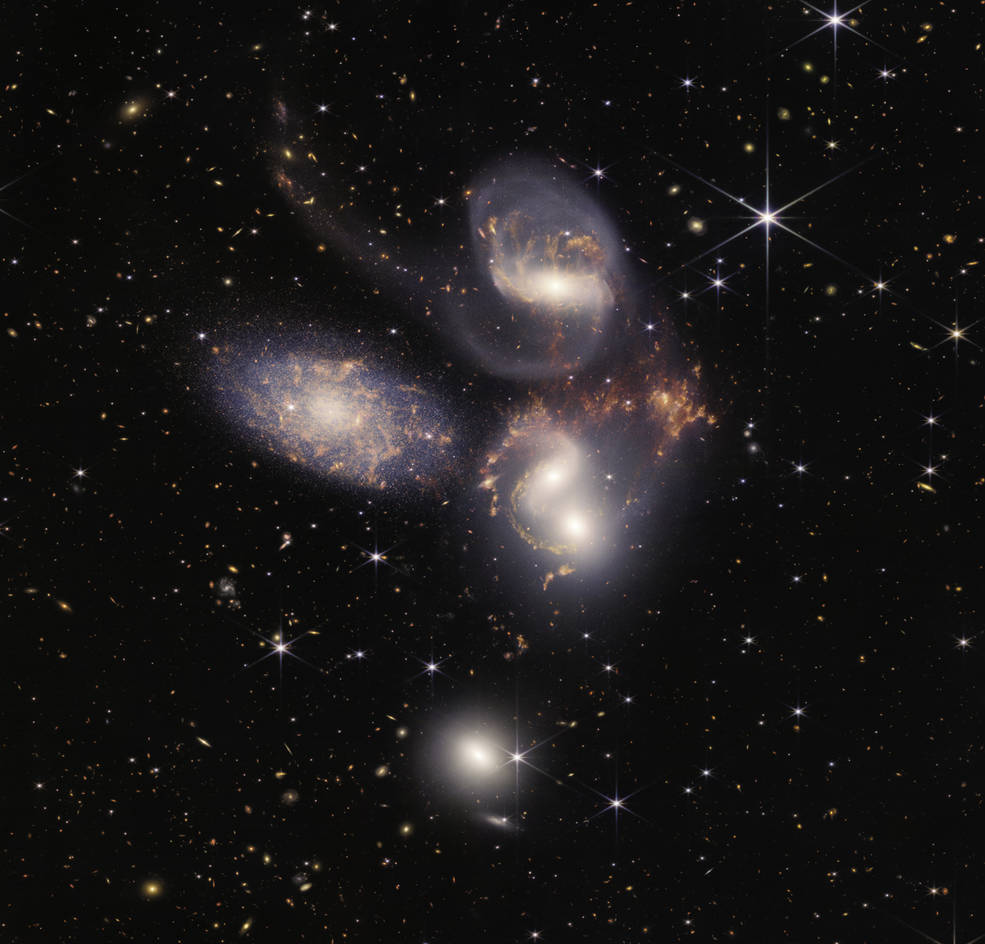
The five galaxies of Stephan’s Quintet, prominently featured at the beginning of the holiday film “It’s a Wonderful Life,” were seen with new eyes by the James Webb Space Telescope.
Located in the northern constellation Pegasus, Stephan’s Quintet consists of four galaxies that are tightly bound — cosmically speaking — about 290 million light-years away. In a coincidence of cosmic alignment, a foreground galaxy lurks on the left of the image about 40 million light-years from Earth.
See the full-resolution view of Stephan’s Quintet.
“With its powerful, infrared vision and extremely high spatial resolution, Webb shows never-before-seen details in this galaxy group,” NASA said in a press release. “Sparkling clusters of millions of young stars and starburst regions of fresh star birth grace the image.
“Sweeping tails of gas, dust and stars are being pulled from several of the galaxies due to gravitational interactions,” NAS A said. “Most dramatically, Webb captures huge shock waves as one of the galaxies, NGC 7318B, smashes through the cluster.”
“This proximity provides astronomers a ringside seat for witnessing the merging and interactions between galaxies that are so crucial to all of galaxy evolution,” NASA said. “Rarely do scientists see in so much detail how interacting galaxies trigger star formation in each other, and how the gas in these galaxies is being disturbed. Stephan’s Quintet is a fantastic ‘laboratory’ for studying these processes fundamental to all galaxies.”
Two of the galaxies are in the process of merging.
“This is a very important area to study because it shows the type of interactions that drive the evolution of galaxies,” said Giovanna Giardino, a scientist working on the Near Infrared Spectrograph instrument on Webb. “That’s the mechanism of galaxy growth.”
“This enormous mosaic is Webb’s largest image to date, covering about one-fifth of the moon’s diameter,” NASA said. The image includes more than 150 million pixels and was constructed from nearly 1,000 separate image files.
The mosaic combines data from Webb’s Near Infrared Camera and Mid-Infrared Instrument, two of the observatory’s four science instruments. NIRCam’s high-resolution imaging capability allowed Webb to see individual stars and the bright core of the foreground galaxy on the left side of the image.
The galaxy at the top of the image harbors a supermassive black hole — or an active galactic nucleus — pulling in matter to generate a shine as bright as 40 billion suns. Webb resolved the fast-moving hot gas near the supermassive black hole “in a level of detail never seen before,” NASA said.
Like all of Webb’s initial batch of images, the galaxies of Stephan’s Quintet are backdropped by a tapestry of fainter galaxies in the more distant universe.
Email the author.
Follow Stephen Clark on Twitter: @StephenClark1.
from Spaceflight Now https://ift.tt/kJnlCe9
via World Space Info







0 comments:
Post a Comment